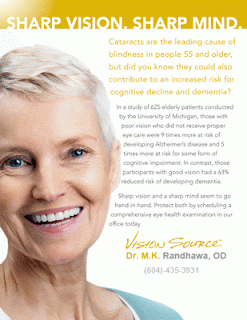Science has shown that increased lutein and zeaxanthin in the diet lowers the risk of cataracts and age related macular degeneration (AMD) two eye diseases that cause permanent vision loss. Catracts can be treated by removing the damaged lens of the eye and transplanting a new artificial lens but AMD has no treatment and the only way to fight it is through prevention. New research suggests that these same nutrients improve cognitive function in the elderly. Read more...
Related articles:
Sharp vision sharp mind
The miracle vitamin gets even more miraculous
Lutein and zeaxanthin - nutrients for eye health
For more information on eye nutrition, visit EyeNutrition.ca.
Related articles:
Sharp vision sharp mind
The miracle vitamin gets even more miraculous
Lutein and zeaxanthin - nutrients for eye health
For more information on eye nutrition, visit EyeNutrition.ca.











